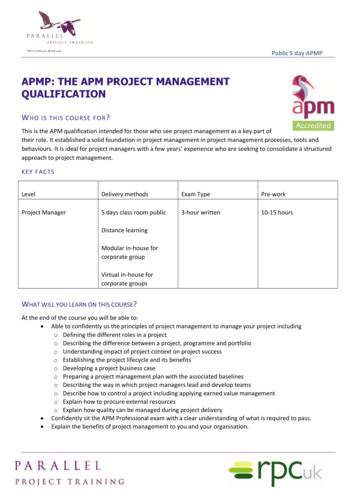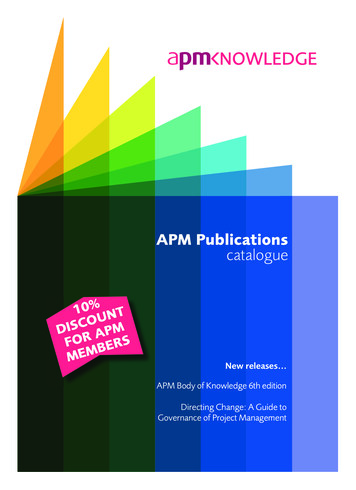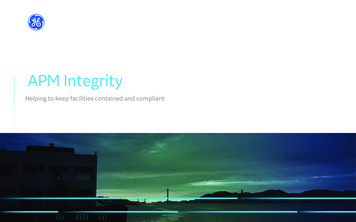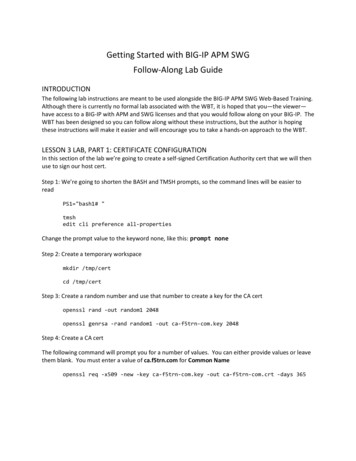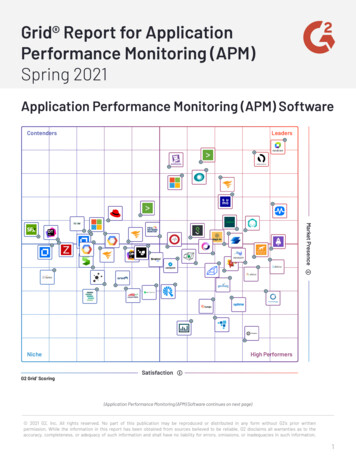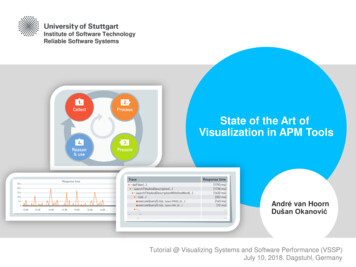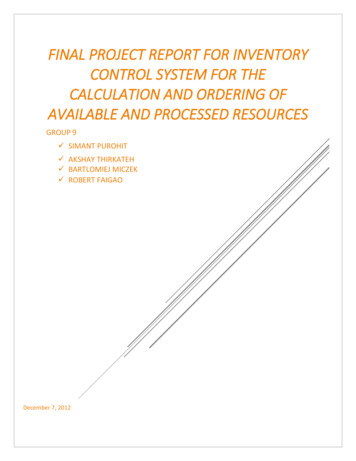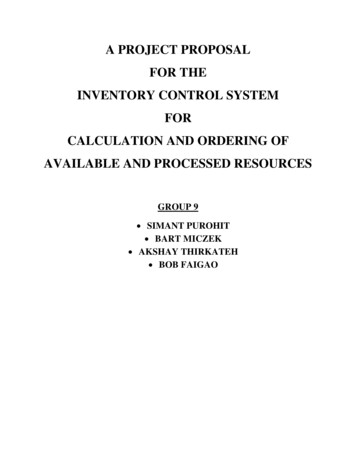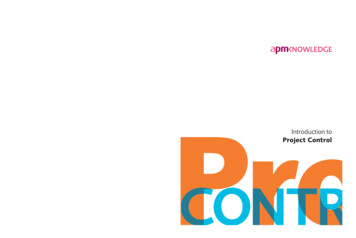
Transcription
Ibis House, Regent ParkSummerleys RoadPrinces RisboroughBuckinghamshire, HP27 9LETelephone 0845 458 1944International 44 (0)1844 271640Facsimile 44 (0)1844 274509Email info@apm.org.ukWeb www.apm.org.ukIntroduction to Project ControlAssociation for Project ManagementIntroduction toProject Control
ContentsForewordAcknowledgementsvvi1 Introduction12 What is project control?2.1 Principles2.2 The spectrum of control2.3 The control processes2.3.1 Inner loop processes2.3.2 Outer loop processes2.4 Relationship to business processes2.5 Relationship to other project management disciplines2.6 The role of the project management plan4457781213153 Why control?3.1 Reasons for control3.2 Reasons projects fail3.3 Relevance to different types of organisation3.3.1 The client organisation3.3.2 The contractor organisation3.3.3 The in-house projects organisation171718191920204 When to control?4.1 The project life cycle4.2 Control activities in each phase4.2.1 Initiation phase4.2.2 Concept phase4.2.3 Definition phase4.2.4 Mobilisation phase4.2.5 Implementation phase4.2.6 Closeout phase4.3 Control leverage on project success4.3.1 Leverage of outer loop control4.3.2 Leverage of inner loop control2121232324242526272728295 Who controls?5.1 Sponsor5.2 Project board5.3 Project manager5.4 Project support experts5.5 Control account managers5.6 Other project team members5.7 Subcontractors3031323233343435iii
Contents5.8 Functions5.9 Client5.10 Other external stakeholders3637376 How to control?6.1 Performing the work – a generic project6.2 Inner loop control processes6.2.1 Performance management6.2.2 Risk management6.2.3 Issue management6.2.4 Review6.2.5 Change management6.3 Outer loop control processes6.3.1 Quality assurance6.3.2 Life cycle management6.3.3 Continuous improvement6.3.4 Portfolio/programme management6.3.5 Governance of project management6.4 Appropriateness, frequency and metrics and reports6.4.1 Appropriateness6.4.2 Frequency6.4.3 Metrics and reports3838424248505154565657606263656566677 Conclusions - characteristics of good project control69Annex A: AbbreviationsAnnex B: Glossary of project planning and control termsAnnex C: Further informationAnnex D: The APM Planning SIGiv73759495
1IntroductionThe APM Body of Knowledge, 5th edition1 defines a project as:“A unique, transient endeavour undertaken to achieve a desired outcome.”The APM Body of Knowledge, 5th edition defines project management as:“The process by which projects are defined, planned, monitored, controlled and delivered so that agreed benefits are realised.”The project management ‘process’ is a combination of numerous individualprocesses, many of which relate to the subsidiary discipline of project control. Much of what a project manager does is directly or indirectly related toproject control, but the APM Body of Knowledge, 5th edition does not explicitlydefine project control and it is rather difficult to arrive at a concise definition.One possible definition of project control is:“The application of processes to measure project performance againstthe project plan, to enable variances to be identified and corrected, sothat project objectives are achieved.”This covers the ‘monitored’ and ‘controlled’ elements of project managementas defined by the APM Body of Knowledge, 5th edition and essentially means“making sure projects are done right”. However, there is more to it than that.This publication proposes that an equally important part of control is “doingthe right projects”, both individually and in programmes and portfolios. Thisensures that the projects which are undertaken by an organisation: deliver the right products, thereby; contributing to the required new capabilities, and hence; providing the desired benefits to the organisation.A wider definition of project control is therefore:“The application of project, programme and portfolio managementprocesses within a framework of project management governance toenable an organisation to do the right projects and to do them right.”To achieve this, project control operates across a spectrum from the tactical tothe strategic, involving much of the overall discipline of project management1Association for Project Management (2006) APM Body of Knowledge, 5th edition, APMKnowledge, ISBN: 978-1-903494-13-41
Introduction to Project Controland involving most of the individual project management disciplines represented by the APM Specific Interest Groups (SIGs).Since so much of project management is involved in project control, theAPM Body of Knowledge, 5th edition naturally includes many control-relatedtopics. This publication draws heavily on these topics, developing them andintegrating them in an attempt to deliver a comprehensive introduction tothe discipline of project control.Some of the topics are already explored in detail in other APM publicationsand many of these are therefore referenced. It is not the aim of this publication to reproduce the content of these other publications in any depth, but tosay enough to provide an integrated view of control. The definitions usedand principles addressed here are broadly consistent with the APM Body ofKnowledge, 5th edition and with the other APM publications, though some tailoring has been necessary to highlight control principles.APM’s Planning SIG (Annex D) has a particular interest in project controlas a natural extension of project planning, which it addresses in the APMpublication Introduction to Project Planning.2 The APM Planning SIG believesthat effective planning and control are both essential for successful projectmanagement. It believes that truly effective control is only possible wheneffective planning has been undertaken. The ability to control is a consequence of good planning and makes planning an investment rather than justa cost. But the ability to control is also a consequence of the other projectmanagement disciplines working properly and so it is probably correct tostate that, apart from a few unique elements, project control is a virtual discipline drawing on the others.Virtual discipline or not, the purpose of this publication is to raise awareness of project control, highlighting its dependence on planning and its relationship with the other project management disciplines. It should be ofinterest to those new to project management, and hopefully also to the project management community in general and in particular to planning andcontrol practitioners.This publication addresses five key questions:1.2.3.4.5.What is project control?Why control?When to control?Who controls?How to control?It also defines the characteristics of good project control. It does not includedetailed treatment of control tools and techniques, several of which are2Association for Project Management (2008) Introduction to Project Planning, APMKnowledge, ISBN: 978-1-903494-28-82
Introductionaddressed in detail in the other APM publications. The APM Planning SIGanticipates building on its introductions to planning and control by developing in-depth guides, which will contain detailed treatment of tools andtechniques used in both planning and control, where not already addressedby APM.3
2What is project control?2.1 PRINCIPLESEven the simplest human endeavours require control. Consider, for example,a cycle trip. A cycle trip, however simple, is a unique, transient endeavour;even if you’ve done similar trips many times before, one of a host of factorsmay have changed – the weather, the road conditions, the traffic, etc. Thistime, the weather forecast is for torrential rain, but even so, a loved one needsyou to make the trip faster than ever before to bring back some chocolatesbefore a particularly good film starts on TV at 8 o’clock. The core work of this‘project’ is pedalling the bike, but a bike is unstable; just riding it requiresconstant attention to both balance and steering, but you also have to avoidobstacles and navigate. Projects are like cycle trips. They’ll take you to yourobjectives, but only if you stay in control, and it’s necessary to stay in controlin order to avoid a nasty crash.Project managers must ensure they control their unique, transient andunstable projects in order to achieve their objectives. Most of what a projectmanager does during the life of a project has a ‘control’ element to it: leadingthe project team, running meetings, managing stakeholders, etc. A lot of theseactivities rely on leadership skills such as effective communication, influencing, negotiation and conflict resolution (such skills are generally described as‘soft’, but they certainly aren’t easy.) The project manager also needs toemploy ‘hard’, quantitative control processes and it is these that are the mainfocus of this publication. These processes address all three project dimensions– quality, time and cost, and therefore include all of the following: Controlling the scope of the project – controlling change. Ensuring that the project’s products/deliverables fulfil their requirements – controlling quality.Ensuring that activities happen on time – scheduling.Ensuring that work is performed within budget – cost control.Managing risks.Managing problems and identifying issues (and obtaining external help toresolve them).Making sure that the project leads to benefits for the organisation.The control processes involve the collection and analysis of data, the identification of trends and variances, forecasting and the reporting of progress. Itis also essential that the information gathered is acted on – without effectiveresponses to actual and potential problems, the project is merely monitored,4
What is Project Control?not controlled. Control is certainly not just about control tools or software,although these are generally necessary to carry out some of the controlprocesses. Neither should control be facilitated only by specialist project control personnel: it must be owned and driven by the project manager withinvolvement of the project team, the project’s sponsor, other stakeholders inthe organisation and possibly external stakeholders too.2.2 THE SPECTRUM OF CONTROLBicycles are unstable and require continuous real-time control through balance and steering. But making a successful bike trip also requires the bike tobe guided around obstacles and to the destination, without getting lost. Youcontrol a cycle trip with a combination of reactive and predictive processes.The processes require feedback via balance, sight and sound; some are routine and have become instinctive through experience (like balance); othersrequire conscious attention (like navigation). There is a spectrum of controlprocesses in operation, within which are processes that can be characterisedas inner loop or outer loop.The inner loop control processes are high-frequency feedback processesoperating in real time, and include: balance – to stay on the bike;vision – to aid balance and to avoid other traffic and obstacles;hearing – to sense other traffic;kinaesthesia (muscle sense) – to control movement.The inner loop processes tell you that you’re going the right way and pedalling fast enough to be home with the chocolates before the film starts. Theyalso warn of risks (i.e. large lorry overtaking) and problems (i.e. it’s startedto rain, I’ve had a puncture and just fallen off).The outer loop control processes are lower frequency, and may not operatein real time; in the bike trip example, they’re mostly associated with decisionmaking and some of them operate before the journey begins, for example: choice of destination;choice of route;choice of transport;choice of equipment;whether or not to continue.The inner loop processes are generally applicable to all bike trips. They helpa particular trip stick to its plan and flag up problems in achieving the plan(e.g. punctures). The outer loop controls are more trip-specific, ensuring thatthe plan for the trip is optimum, in the light of experience of numerous otherbike trips, and if necessary revising the plan in response to trends and eventsin the journey.5
Introduction to Project ControlMore proactiveMore reactiveLower frequencyHigher frequencyMore formalMore informalExternal to the projectInternal to the projectBusinessPortfolio/programmeProjectMore strategicMore tacticalDoing the right projectDoing the project right‘Control’ processes‘Management’ processes‘Inner loop’ processes‘Outer loop’ processesFigure 1: The spectrum of control6
4When to control?4.1 THE PROJECT LIFE CYCLEA project is a transient endeavour with a start and a finish, and betweenthese events it goes through several distinct phases which constitute the project life cycle. The focus of project management in general and of project control in particular changes from phase to phase, so an understanding of thelife cycle is vital. Some organisations fail to distinguish the phases or skimpsome of them, to the detriment of effective project management. Not all projects make it all the way through the life cycle; some projects should not beimplemented at all because their business cases are inadequate and othersmay have to be terminated because of changing circumstances or poor performance.Each project is unique but there is much commonality between the lifecycles of projects. It is possible to define and apply a generic life cycle to anorganisation’s projects. Life cycle management ensures adherence to theorganisation’s life cycle model and brings rigour and discipline to the organisation’s projects.The project life cycle model in the APM Body of Knowledge, 5th edition consists of the following phases: concept; definition; implementation; handoverand closeout. The APM Body of Knowledge, 5th edition regards handover andcloseout as a single phase and notes that some projects are extended toinclude operation and termination phases. Termination covers the disposalof project products/deliverables at the end of their useful life. Logically, closeoutshould be the last phase of the project, what
The APM Body of Knowledge, 5th editiondefines project management as: “The process by which projects are defined, planned, monitored, con-trolled and delivered so that agreed benefits are realised.” The project management ‘process’ is a combination of numerous individual processes, many of which relate to the subsidiary discipline of project con-trol. Much of what a project manager does .

